2.2.1, 2.2.2, 2.2.3 Biomedical sciences
1/105
Earn XP
Description and Tags
unit 2.2 ~ decoding a diagnosis 2.2.1: 1-52 2.2.2: 53-79 2.2.3: 80-
Name | Mastery | Learn | Test | Matching | Spaced |
|---|
No study sessions yet.
106 Terms
What is the job/ role of a pathologist
a medical professional who examines bodies, tissues, and fluid samples to look for changes or other signs of disease and collaborate with other healthcare providers to diagnose patients.
What is the job/ role of a cytopathologist
A pathologist who focuses on diagnosing diseases at the cellular level
What is the job/ role of a cytogeneticist
A cytogeneticist is an expert in cytogenetics, specializing in studying chromosomes to diagnose genetic disorders and guide treatment decisions. They use techniques like karyotyping and FISH to detect chromosomal abnormalities associated with diseases, contributing to advancements in medical genetics.
FISH: Fluorescence In Situ Hybridization
What is the job/ role of a Music therapist
A music therapist is a professional who uses music-based interventions to address physical, emotional, cognitive, and social needs, working in various settings to improve well-being through activities like singing, playing instruments, and listening to music.
What is the role of a Geneticist
field of genetics, which is the study of genes, heredity, and genetic variation in living organisms. Geneticists investigate the structure, function, and behavior of genes and genomes, as well as how genetic information is passed from one generation to the next. They may conduct research to understand the molecular mechanisms underlying genetic disorders, evolutionary processes, and the relationships between genes and traits. Geneticists also apply their knowledge to fields such as medicine, agriculture, forensics, and biotechnology, contributing to advancements in diagnosis, treatment, and genetic engineering.
What is the job/ role of a genetic counselor
A genetic counselor is a healthcare professional trained in medical genetics and counseling. They work with individuals and families to assess the risk of genetic conditions, provide information about genetic testing options, interpret test results, and offer support and guidance in making informed decisions about their healthcare and family planning.
what does it mean for a tumor to be beign
means it is harmless
what does it mean for a tumor to be malignant
it means that the tumor in question is cancerous and that is has/is/will metastasize
what is the spread of cancer called?
metastasis
what are causes of malignant tumors?
Genetics (inheriting predisposition from parents)
Behavioral Causes
Diet
Unsafe sex leading to viral infection (ex: HPV)
Tobacco use
Excessive exposure to UV radiation (in the sun or by using tanning beds)
Inflammation (ex: obesity leads to inflammation which may lead to cancer)
what are somatic cells?
body cells
what are the two types of cells that we have?
somatic cells
gametes (sex cells: sperm and eggs that come together to make a zygote… the beginning of a baby)
what does a cell life cycle consist of?
Interphase
G1
S
G2
M phase or Mitosis: Painters Mix Artistic Techniques
prophase
metaphase
anaphase
telophase
Cytokinesis
during interphase, what occurs in G1?
The cell grows and works
the cell is diploid → 23 pairs of chromosomes in chromatin form
GROWS
What occurs during S phase of Interphase?
here chromosomes in chromatin form replicate and the two sister chromatids bind
what occurs during G2 phase of interphase
again, the cell grows and works. Organelles replicate.
NOTE: INTERPHASE
think of interphase like this:
G1→ G= grows
S → S= synthesis cell synthesizes a complete copy of the DNA in its nucleus
G2 → G= grows, 2 = organelles replicate
during M-Phase, mitosis, what occurs in prophase
chromosomes condense and centrosomes move to opposite sides of the nucleus, initiating formation of the mitotic spindle
during M-Phase, mitosis, what occurs in metaphase
the nucleus dissolves and the cell's chromosomes condense and move together, aligning in the center of the dividing cell
during M-Phase, mitosis, what occurs in anaphase
the sister chromatids separate from each other and are pulled towards opposite ends of the cell
during M-Phase, mitosis, what occurs in telophase
the cell is nearly done dividing, and it starts to re-establish its normal structures as cytokinesis (division of the cell contents) takes place
when in the cell cycle does DNA replicate
during S-phase
what is a differential diagnosis
a list of possible diseases or disorders based on this information.
when does does the replicated chromatin condense into chromosomes
during prophase
in which phase do mutations happen
during s phase
how many chromosomes are normally in cells?
46
Normally, each cell in the human body has 23 pairs of chromosomes (46 total chromosomes)
difference between transcribing DNA and translating DNA
The process by which DNA is copied to RNA is called transcription, and that by which RNA is used to produce proteins is called translation.
sister chromatids
identical copies of a single replicated chromosome held together until cell division
chromatin
is DNA packaged with proteins in the nucleus, regulating gene expression and chromosome structure
chromatin is wrapped around histone proteins
looks like beads on a thread-like structure within the nucleus of the cell when the cell is not dividing
becomes more condensed and visible as distinct chromosomes during cell division
what is DNA
a molecules that carries genetic instructions for the developments, functioning, and reproduction of living organisms
what are chromosomes
are structures within the cell that contain genetic material including DNA, genes, and proteins
They are visible during cell division
carry the genetic information necessary for cell function and inheritance
what are chromatids
are two identical copies of a chromosome that are joined together at the centromere
formed during DNA replication
separated during cell division→ ensuring each daughter cell receives a complete set of genetic information
what is a centromere?
a specialized region of a chromosomes where the two sister chromatids are joined together
plays crucial role in the proper segregation of chromosomes
what are epithelial cells
typical, non-cancerous cells
what is basal cell carcinoma
Basal cell carcinoma is a type of skin cancer that originates in the basal cell layer of the epidermis. The epidermis is the outermost layer of skin.
In basal cell carcinoma, basal cells are mutated and replicate uncontrollably. These abnormal basal cells form tumors within the skin and on the skin surface
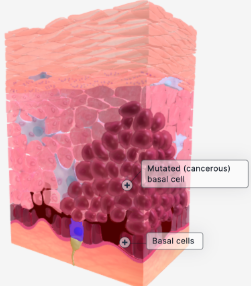
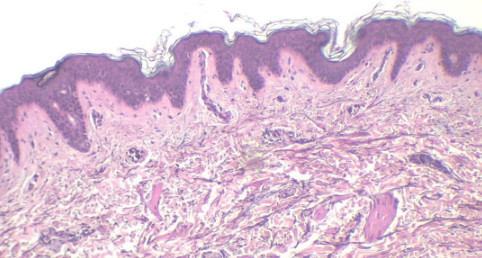
Which one: Basal Cell Carcinoma OR Normal Epithelium
Normal Epithelium
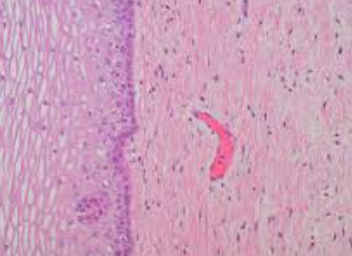
Which one: Basal Cell Carcinoma OR Normal Epithelium
Normal Epithelium
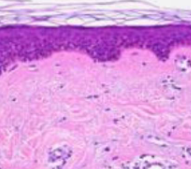
Which one: Basal Cell Carcinoma OR Normal Epithelium
Normal Epithelium
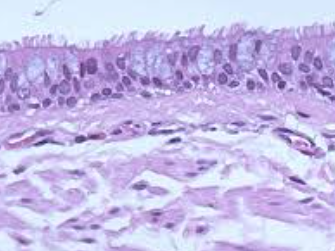
Which one: Basal Cell Carcinoma OR Normal Epithelium
Normal Epithelium

Which one: Basal Cell Carcinoma OR Normal Epithelium
Basal Cell Carcinoma
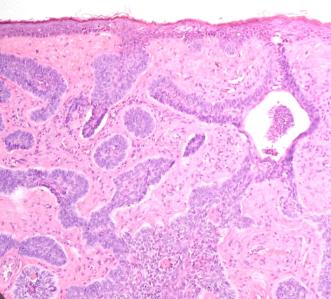
Which one: Basal Cell Carcinoma OR Normal Epithelium
Basal Cell Carcinoma

Which one: Basal Cell Carcinoma OR Normal Epithelium
Normal Epithelium
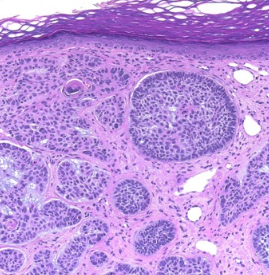
Which one: Basal Cell Carcinoma OR Normal Epithelium
Basal Cell Carcinoma
what is a biopsy
the removal of cells or tissues from a patient’s body using a needle, scalpel, or other tools to study them more closely using a microscope.
what are the types of biopsy (5)
fine needle aspiration: needle attached to syringe to collect little tissue
excisional: removal of entire tissue
Shave: sharp tool: removal on skin’s surface
punch: sharp, circular tool to remove sample from below surface
endoscopic: small, thin, flexible tube (w/ light, camera, and forceps to see inside body and remove tissue samples)
What is an MRI
magnetic resonance imaging
what are solid mass tumors
abnormal growths of tissue that form a visible lump or mass
consist of cells that have undergone uncontrolled proliferation and often have the potential to invade surrounding tissues or spread to other parts of the body.
what are homologous chromosomes
are chromosome pairs (one inherited from each parent)
are similar in length, gene position, and centromere location
They carry the same genes, although the specific alleles may differ
Homologous chromosomes are crucial during meiosis
what is normal blood pressure?
A normal blood pressure level is less than 120/80 mmHg
which phase in a cell's life cycle is DNA replicated
interphase

what is the correct order?
E
B
D
A
C
F

what is Neurofibromatosis Type 1, or NF1
NF1 is an example of a genetic disorder.
how common are mutations leading to genetic disorders?
uncommon, but they do happen
what does neurofibromin do?
Neurofibromin regulates mitosis, and works to prevent cells from growing and dividing in an uncontrolled way.
The cells of individuals with a mutated NF1 gene have mutated neurofibromin proteins, and thus divide out of control, leading to the creation of tumors.
what are the two steps of protein synthesis
NUCLEUS: DNA is transcribed into mRNA molecules.
RIBOSOME: mRNA is then translated into a protein.
what is transcription
Transcription is like copying Grandma’s cookie recipe onto a notecard by hand.
what is translation
Translation is like reading the notecard to friends who add ingredients in a particular order to make the cookie dough.
what are genetic disorders
health conditions caused by genes that are different from normal functioning genes
what are genes
Genes are units of heredity containing instructions for traits, located on chromosomes, and governing the production of proteins and other molecules crucial for cell function and organism development.
what are the four nucleotides
A, T, C, and G → It is the sequence of these nucleotides that determine the gene recipe.
what are amino acids
amino acids = proteins
Special molecules bring specific amino acids to the ribosome, which bond together to make an amino acid chain. (TRANSLATION)
what is a polypeptide
an amino acid chain in called a polypeptide
The polypeptide
bends and folds into a shape
often binds to other polypeptides
becomes a functional protein
what is mRNA
a molecule that carries genetic information from the DNA in the cell nucleus to the ribosomes in the cytoplasm, where proteins are synthesized
It serves as a template for protein synthesis during the process of translation
what does a ribosome do
INFLUENTIAL IN PROTEIN SYNTHESIS: “the 3D printer of the cell”
In the nucleus, a DNA gene is copied. (TRANSCRIPTION)
The copy leaves the nucleus & goes to a ribosome.
The ribosome reads the gene copy, one codon at a time.:
ribosome attaches to the mRNA and reads each codon (group of 3 bases) in sequence.
Special molecules bring specific amino acids to the ribosome, which bond together to make an amino acid chain. (TRANSLATION)
As amino acids come to the ribosome, they bond together to make a polypeptide chain
When the last amino acid is added, the chain is complete! It is called a polypeptide.
BASICALLY: he ribosome reads the mRNA recipe in 3-letter groupings called “codons”.
codons and anticodons
CODONS:
Codons are sequences of three nucleotides in mRNA that correspond to specific amino acids during protein synthesis. They serve as the genetic code that determines the order of amino acids in a protein.
ANTICODONS:
Anticodons are sequences of three nucleotides found in tRNA molecules, complementary to the codons in mRNA. They recognize and bind to the codons during translation, ensuring the accurate placement of amino acids in the growing polypeptide chain.
EXAMPLE:
mRNA codon: A U G
tRNA anticodon: U A C
what is tRNA
a molecule that brings amino acids to the mRNA on the ribosome.
tRNA has anticodons, which are complementary to codons. (Use the base-pairing rules to figure out).
rough ER
The endoplasmic reticulum (ER) is a complex network of membranes within the cell that is involved in various cellular processes. The rough endoplasmic reticulum (RER) is studded with ribosomes, giving it a "rough" appearance, and is primarily involved in protein synthesis, modification, and transport. It plays a crucial role in synthesizing proteins that are destined for secretion, membrane proteins, and proteins targeted for specific organelles.
smooth ER
On the other hand, the smooth endoplasmic reticulum (SER) lacks ribosomes and is involved in lipid synthesis, detoxification of drugs and toxins, and regulation of calcium levels in the cell. It plays key roles in lipid metabolism, steroid hormone production, and detoxification processes within the cell.
Golgi
The Golgi apparatus processes, modifies, and sorts proteins and lipids synthesized or imported by the cell, adding carbohydrate chains, trimming molecules, and directing them to specific destinations such as secretion, lysosomes, or the cell membrane.
point mutations (2)
substitutions: replace
inversion: switch
frameshift mutations (2)
insertion: add
deletion: loose
Beta Globin
a type of genetic disease
sickle cell disease results from changing one DNA base in the beta globin gene
Hemoglobin is composed of four polypeptides. Two of them are called Beta Globin (𝜷1 and 𝜷2 at top)
DNA sequencing
a process that determines the order of DNA bases that compose our genes.
prognosis
the likely course the disease will take over his lifetime
bioinformatics tools
software programs that analyze DNA
what is Tay Sachs Disease
Tay-Sachs disease is a rare genetic disorder caused by a deficiency of an enzyme called hexosaminidase A (Hex-A).
This enzyme deficiency leads to the accumulation of specific lipids, particularly GM2 ganglioside, within nerve cells in the brain and spinal cord.
Symptoms typically appear in infancy and progress rapidly, including developmental regression, seizures, loss of motor skills, and eventually blindness and paralysis.
Tay-Sachs disease is ultimately fatal, with affected individuals typically surviving only into early childhood or adolescence. There is currently no cure for Tay-Sachs disease, and treatment focuses on managing symptoms and providing supportive care.
in eukaryotic cells, where does transcription occur
a nucleus
order the parts of protein synthesis
RNA is made from a DNA gene
RNA gets edited
RNA binds to a ribosome
Ribosome reads the RNA codons
Ribosome assembles amino acids in order
Amino acid strand forms a polypeptide
inheritance
Inheritance refers to the passing of genetic traits or characteristics from parents to offspring through the transmission of genes.
genotype
Genotype refers to the genetic makeup or combination of alleles present in an organism, influencing its traits and characteristics.
phenotype
Phenotype refers to the observable physical and biochemical traits of an organism, resulting from the interaction between its genotype and the environment
allele
genes can have different forms which are called alleles. these can be passed down to offspring
homologous chromosomes
homozygous dominant
a homozygous dominant genotype occurs when an individual possesses two copies of a dominant allele for a particular gene. This means that both alleles at the gene locus are the dominant form, resulting in the expression of the dominant trait.
homozygous recessive
a genetic condition in which an individual carries two copies of a recessive allele for a particular gene. In this case, both alleles at the gene locus are the recessive form, leading to the expression of the recessive trait.
heterozygous
refers to a genetic condition in which an individual carries two different alleles for a particular gene, one dominant and one recessive. In a heterozygous genotype, one allele typically masks the expression of the other, leading to the dominance of the dominant allele's trait.
carrier
A carrier refers to an individual who carries one copy of a recessive allele for a genetic disorder but does not display any symptoms of the disorder. Carriers can pass on the recessive allele to their offspring, potentially resulting in the expression of the disorder in future generations if the other parent also contributes a copy of the recessive allele.
gene expression
Gene expression is the process through which information encoded in a gene is transcribed into mRNA and translated into proteins or RNA molecules, regulated by environmental factors, developmental stages, and cellular signaling pathways, ultimately determining an organism's phenotype.
Gamete
A gamete is a specialized reproductive cell, either an egg (ovum) in females or a sperm in males, that carries half the genetic material of a parent and is involved in sexual reproduction, combining with another gamete to form a zygote with a full set of chromosomes.
haploid
Haploid refers to a cell or organism having a single set of chromosomes, typically denoted as "n", which is half the number of chromosomes found in diploid cells. Haploid cells are characteristic of gametes (sperm and egg cells) in sexually reproducing organisms.
sperm, egg, fertilization, zygote, diploid
Sperm and egg cells are specialized reproductive cells, with sperm being produced by males and eggs by females. Fertilization occurs when a sperm cell fertilizes an egg cell, resulting in the formation of a zygote, which is the initial stage of a new organism's development. The zygote is diploid, meaning it contains two sets of chromosomes, one from each parent.
pedigree
A pedigree is a diagram or chart that shows the genetic relationships within a family, typically across generations, highlighting the inheritance patterns of traits or genetic conditions. It often includes information about individuals' phenotypes, genotypes, and familial relationships, aiding in the study of genetic disorders and inheritance.
generation
generations are used to describe the passage of genetic traits from parents to offspring, with each generation representing a stage in the transmission of genetic material.
inheritance patterns (6)
Autosomal Dominant Inheritance: In this pattern, a single copy of the dominant allele from one parent is sufficient to express the trait or disorder.
Autosomal Recessive Inheritance: Both copies of the recessive allele must be present for the trait or disorder to be expressed. Carriers, individuals with one copy of the recessive allele, do not typically show symptoms.
X-linked Dominant Inheritance: Dominant alleles on the X chromosome can be expressed in both males and females. Males and females can inherit X-linked dominant disorders from either parent, but fathers cannot pass X-linked traits to their sons.
X-linked Recessive Inheritance: Recessive alleles on the X chromosome typically affect males more frequently than females because males have only one X chromosome. Females must inherit two copies of the recessive allele to express the trait, while males need only one.
Y-linked Inheritance: Traits or disorders carried on the Y chromosome are passed from fathers to sons and are not typically seen in females.
Mitochondrial Inheritance: Mitochondrial DNA (mtDNA) is inherited solely from the mother. Traits or disorders caused by mutations in mitochondrial DNA are passed from mothers to all of their offspring but are only expressed in individuals who inherit a sufficient number of defective mitochondria.
Autosomes (chromosome pairs #1 through #22)
in a diploid cell.
They carry genes responsible for the majority of an organism's traits and characteristics, excluding those related to sex determination
Sex chromosomes (X and Y chromosomes)
Sex chromosomes, including the X and Y chromosomes in humans, determine an individual's sex: females typically have two X chromosomes (XX) while males have one X and one Y chromosome (XY), with the X chromosome carrying genes essential for both sexes and the Y chromosome containing genes responsible for male characteristics and development.
Autosomal dominant, autosomal recessive
Autosomal Dominant Inheritance:
In autosomal dominant inheritance, a single copy of the dominant allele from one parent is sufficient to express the trait or disorder.
The presence of the dominant allele overrides the expression of the recessive allele.
An affected individual usually has one affected parent.
Every affected individual has at least one affected parent.
An affected individual has a 50% chance of passing the dominant allele to each offspring, regardless of the offspring's sex.
Autosomal Recessive Inheritance:
In autosomal recessive inheritance, both copies of the recessive allele must be present for the trait or disorder to be expressed.
Carriers, individuals with one copy of the recessive allele, do not typically show symptoms but can pass the allele to their offspring.
An affected individual usually has unaffected parents who are carriers of the recessive allele.
The chance of an affected individual passing the recessive allele to their offspring is 50% if the other parent is also a carrier.
Affected individuals often appear sporadically in families without a history of the disorder.
Familial Hypercholesterolemia (FH)
an autosomal dominant genetic condition that causes the “bad” LDL cholesterol levels to be very high, making you more likely to have atherosclerosis, or narrowing of the arteries.
Atherosclerosis
narrowing of the arteries